_We may earn revenue from the products available on this page and participate in affiliate programs. Learn more ›
_
Best Overall
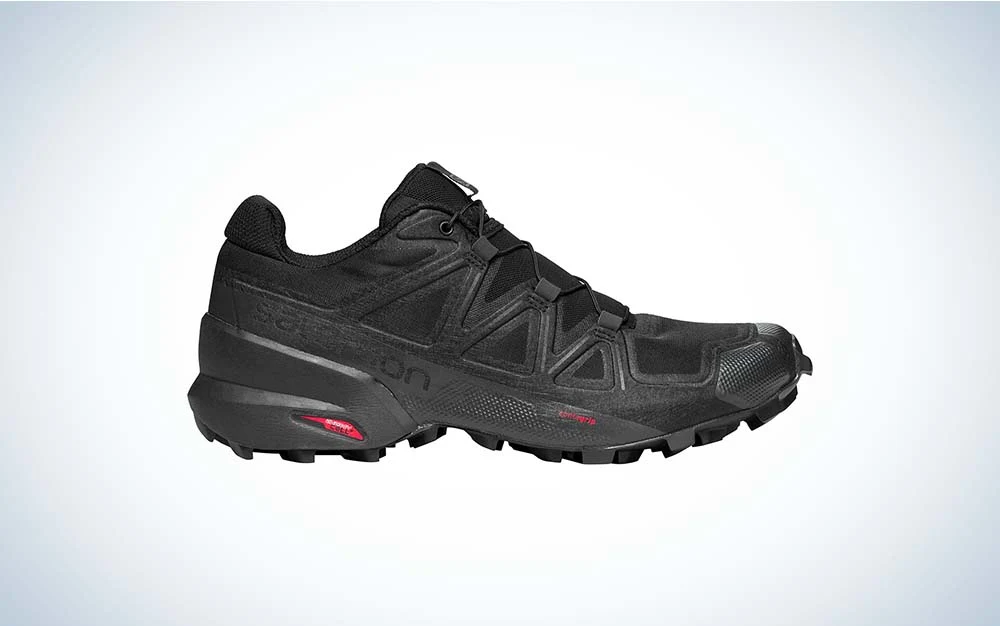
Speedcross 5 Trail Running Shoe
Best Hiking Boots
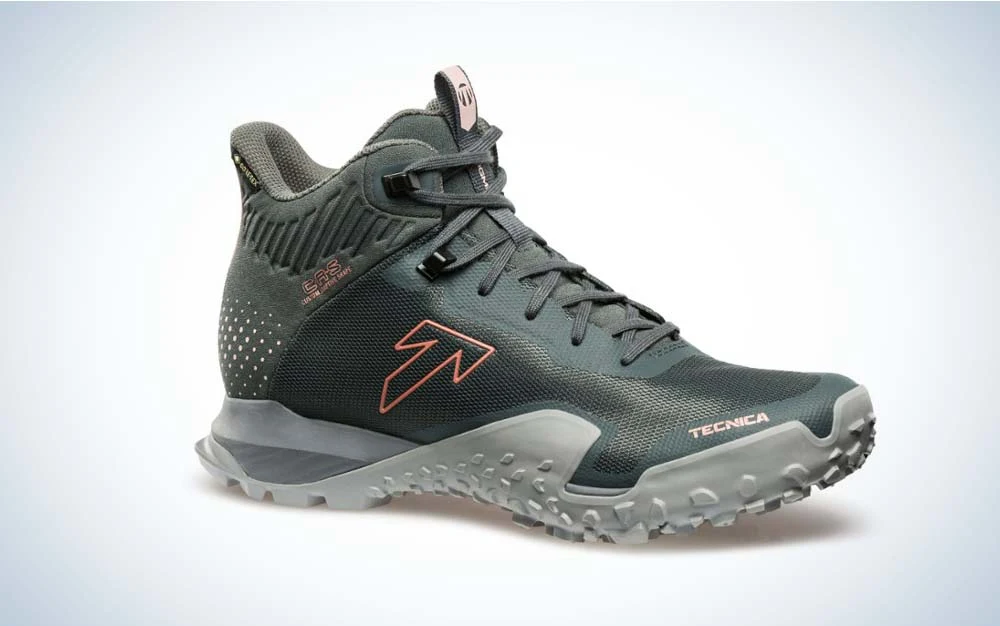
Tecnica Magma S Mid GTX Hiking Boots
Best Budget
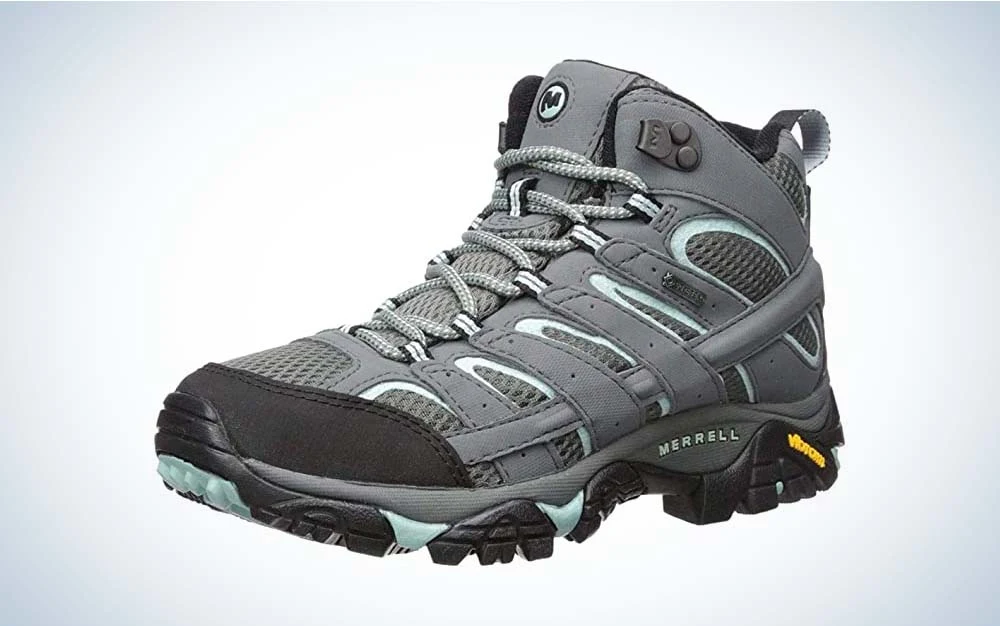
Merrell Moab 2 Mid WP
The best hiking shoes for women are the ones that fit your feet and your chosen adventure. Not everyone hikes on the same type of trails and terrain, nor do they require the same level of comfort or support. Other things like foot shape, age, and fitness level can also influence hiking shoes best suit your needs.
When discussing hiking shoes, this can mean one of two things: a sneaker-type shoe or trail runner used while hiking, or it can simply be the general category of shoes commonly used for hiking. For this review, I chose hiking shoes as a general category. By doing so, I can provide a broader range of hiking shoe options, making you more likely to discover the best hiking shoes for women.
Best Overall: Salomon Speedcross 5
Best Hiking Boots: Tecnica MAGMA S MID GTX
Best for Wide Feet: KEEN Women’s TARGHEE II Mid Waterproof Hiking Boot
**Best Hiking Sandals: Chaco Z1 Classic
**
Best Winter Boots: Merrell Thermo Kiruna
**Best Budget: Merrell Moab 2 Mid WP
**
How We Made Our Picks
Finding the best hiking shoes for women is a process. Much like buying clothing and having different body types, many of us have different foot shapes and needs regarding support as we hike. In choosing hiking shoes, being aware of your needs and personal preferences is the perfect place to start. With that in mind, we did our best to include a variety of shoe styles and options in our picks to help you see what is out there and begin to narrow things down.
In choosing our top picks for the best hiking shoes for women, we considered what is covered in the “things to consider before buying” section at the bottom of this article, and we looked at:
Intended use: Does this boot fit my needs? How often will I use them? What season, terrain, and type of trail am I hiking? What is the weather and climate in that area?
Sustainability and Durability: What are the shoes made from? Are they durable? Is the company transparent about sustainable practices and production? Is there a company repair policy? How long do the boots last? Do I need to know specific maintenance to ensure longevity?
When possible, product testing is conducted. Other things like verified customer reviews, company referrals, and information about the product life cycle were also considered. These reviews and recommendations are updated periodically to reflect new releases and further product testing.
The Best Hiking Shoes for Women: Reviews and Recommendations
Best Overall: Salomon Speedcross 5
Best Overall

Key Features
Weight: 9.9 oz
Shoe Type: trail runners
Best Use: running, hiking, backpacking, thru-hiking
Pros
Great on wet terrain
Traction good for mud and snow
Breathable
Quick closure
Cons
Runs large (go down a size)
For the best overall hiking shoe, we wanted to choose a trail-running shoe instead of a hiking boot. We feature hiking boots on this list, but since these are the best hiking shoes for women, we felt trail runners were an excellent fit for the top choice. The Salomon Speedcross 5 is a classic choice for trail runners and thru-hikers. The large lugs provide ideal traction in wet, muddy, and even snowy conditions.
The shoe’s durability is about on par with other trail runners of the same caliber and will last much longer if you are using them as a simple day hiking shoe versus on a thru-hike. With the right fit, these shoes don’t cause too many issues with hot spots, but women with wide feet may struggle with the narrow toe box. We recommend trying these shoes on in person as they tend to run quite large (about one size).
Best Hiking Boots: Tecnica MAGMA S MID GTX
Best Hiking Boots

Key Features
Weight: 11.3 oz
Shoe Type: lightweight hiking boot
Best Use: hiking, backpacking
Pros
Lightweight
Waterproof
Excellent traction
Stylish design
Durable
Cons
Not very breathable
Ranked as one of the top hiking boots for women
and our top reviewed hiking boots
, it was impossible not to include the Tecnica MAGMA S MID GTX as one of the best hiking shoes for women as well. These boots are unbeatable if you want a hiking shoe with the classic boot design, but it doesn’t feel quite as clunky. They have a standard boot lace-up system, and the laces feel flimsy but hold up quite well with consistent use. Plus, laces are the easy part of the boot to replace if you need to.
These boots won’t work very well in hot weather, but they are ideal for wet climates. In rain, puddles, snow, mud, and more, these boots can do it. Although the lugs on these boots are small, the traction and rubber chosen for the sole provide a stable and sturdy grip, even when hiking on wet surfaces. The lightweight feel of the boots makes it seem like you are wearing trail runners with the bonus of providing the ankle support of a hiking boot.
Best for Wide Feet: KEEN Women’s TARGHEE II Mid Waterproof Hiking Boot
Best for Wide Feet
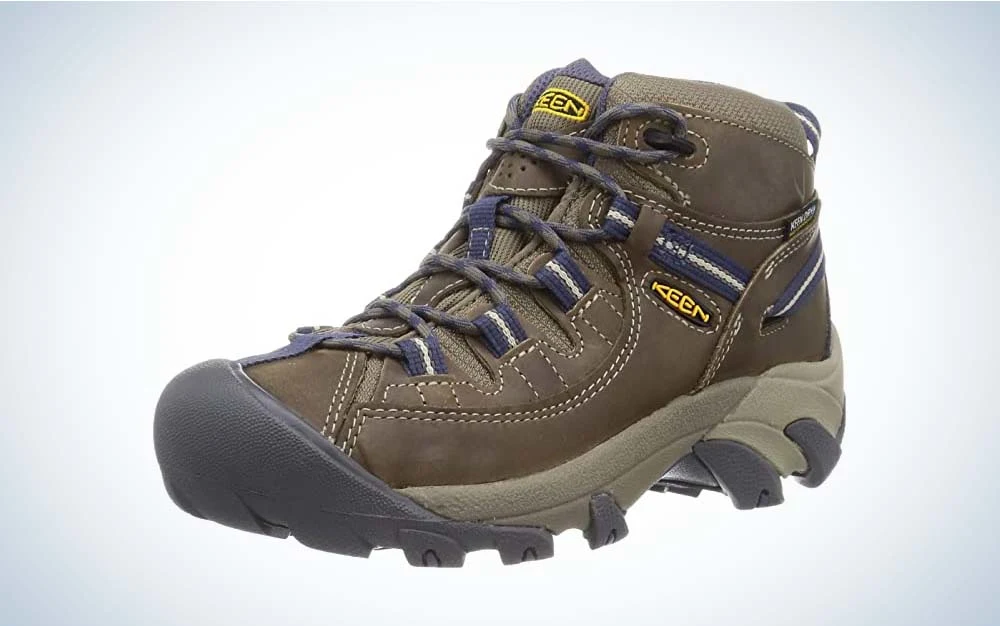
Key Features
Weight: 15 oz
Shoe Type: lightweight hiking boot
Best Use: hiking, backpacking
Pros
Comfortable fit
Wider toebox than others
Durable construction
Waterproof
Low profile
Cons
Runs small (about ½ size)
Featured as one of the best wide-feet hiking boots
, the KEEN Women’s TARGHEE II Mid Waterproof hiking boots are an excellent choice if you’re looking for a sturdy, functional hiking shoe that fits comfortably. Known for designing shoes that fit wide feet better, they are designed with wide-foot women in mind. KEENs may be better for wide feet because the toe box isn’t usually as narrow as other hiking shoe designs. Although the toe box is a bit roomier, the right fit will ensure your feet do not slide or move around, causing friction sores as you hike. These shoes tend to run a bit small, so we recommend trying them in person.
The leather uppers are treated with PFT-free water-repellent and are combined with an interior membrane for a functionally waterproof design. Small mesh panels on the shoe provide just enough breathability that they are comfortable in most hiking conditions. The durability of these hiking shoes is excellent, but if you use them frequently, you may see wear on the mesh panels first.
Best Hiking Sandals: Chaco Z1 Classic
Best Hiking Sandals
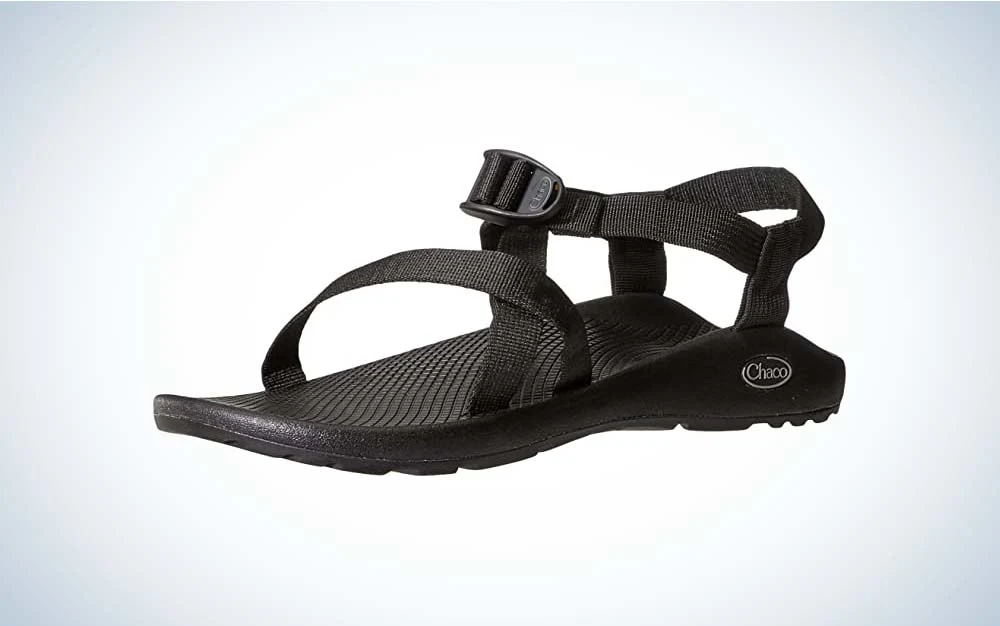
Key Features
Weight: 1 lbs 14 oz
Shoe Type: hiking sandal
Best Use: hiking, paddling, daily wear
Pros
Durable
Versatile use
Decent traction
Secure webbing and fit
Cons
Clunky feel
are more your style, you can’t go wrong with the Chaco Z1 Classic. Some hikers may find the Chaco soles a bit too thick or clunky, but many enjoy their durability and strong support. If you hike on rocky terrain, in areas with river crossings, or like to have a hiking shoe that you can also use for paddling, we cannot recommend these enough.
Unlike many other hiking sandals, Chaco is known for providing the outsole and midsole support of a hiking boot while still giving you the freedom and breathability of a sandal. There are many hiking sandal designs, and Chaco has others that work well for men, women, and children.
Best Winter Boots: Merrell Thermo Kiruna
Best Winter Boots
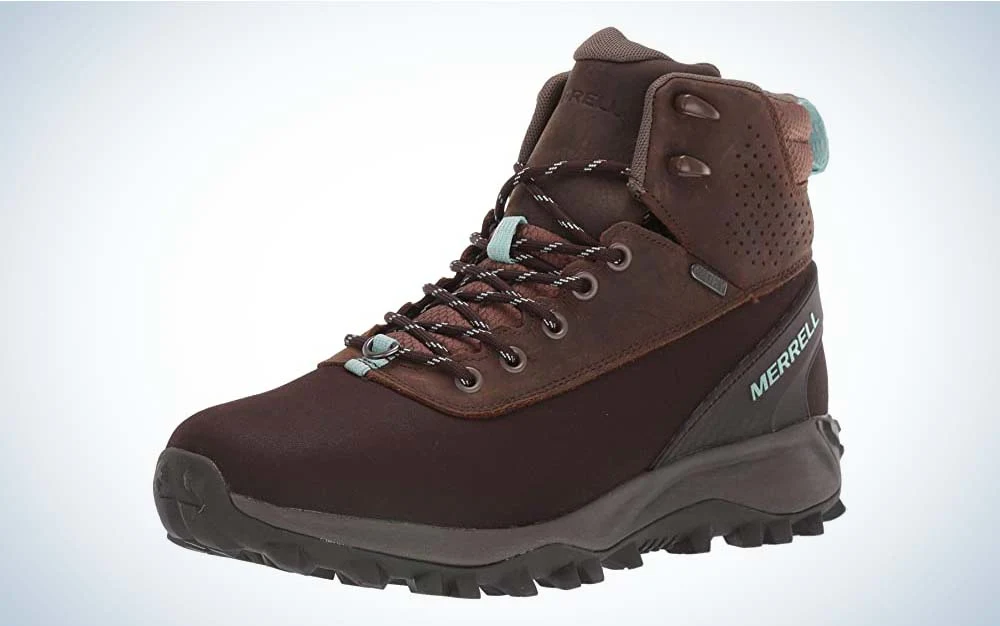
Key Features
Weight: 2 lbs 1 oz
Shoe Type: hiking boot, winter boot
Best Use: winter hiking, daily winter use
Pros
5mm lug depth
Waterproof
Short break in period
Supportive design
Cons
Run small (about ½ size)
If hiking in winter is your concern, or you want a reliable winter boot that can double as your winter hiking shoes, then consider the Merrell Thermo Kiruna. Ranked as our best winter boots for women
, these boots work well as daily wear winter boots, are suitable for walking the dog, or as a winter hiking shoe. Depending on who you are, the sturdy and somewhat stiff feel of the boots could be a pro or a con. These boots are not the best for women with wide feet, but if you want a secure feel while winter hiking, these boots could be an option.
While these are winter boots, remember that they’re designed for moderate activity. So, the insulation likely isn’t warm enough if you’re standing around, but they’ll be great as you hike. These boots feature a waterproof design and will keep your feet dry so long as no snow enters the top of the boot. Take note that the sizing is a bit off, and they run small, so try them on in person if possible.
Best Budget: Merrell Moab 2 Mid WP
Best Budget

Key Features
Weight: 2.25 lbs (pair)
Shoe Type: lightweight hiking boots
Best Use: day hiking
Pros
Affordable
Decently comfortable
Accurate sizing and fit
Cons
Not the most durable option
If you’re in the market for a budget hiking shoe, then the Merrell Moab 2 is a great place to start. These hiking shoes provide the traction and stability needed for most day hikes on maintained trails. Although the design has been updated and improved in recent years, we still find that the traction and support of the shoe aren’t quite cut out for rugged terrain or extended backpacking trips.
Still, if you are starting out and just want something that gets you outside on the trail, these will provide you with the necessary level of comfort. Merrell is also a brand known for their shoe fit with wide feet, so try these if you have wide feet and are struggling to find a comfortable hiking shoe. The only real downside to buying a budget shoe is that you can almost guarantee that the lifespan and durability aren’t going to be as long.
What to Consider Before Buying The Best Hiking Shoes for Women
Type of Hiking Shoe
The type of hiking shoe you need has a lot to do with personal preference, type of terrain, season, climate, and intended use (day hikes, backpacking, thru hiking, trail running). Many hikers like to have shoes that can work well for a variety of activities and types of hiking, so they don’t need to invest in different shoes for each activity.
Common types of hiking shoes include:
Hiking Boots: The most stable and supportive option, hiking boots come in lightweight, midweight, and heavyweight options. Hiking boots provide more ankle support and tend to have better traction and waterproofing than other hiking shoes.
Trail Runners: A classic thru-hiking choice, trail runners are lightweight running shoes with more durable construction and more traction to provide better stability while running on uneven terrain.
Trainers: You can hike in your standard running shoes, sneakers, or trainers. The only downside is that they are less durable and won’t have as good traction. These are still a decent option for well-maintained trails or short day hikes.
Hiking Sandals: Hiking sandals are durable sandals that provide a secure fit and have good enough traction to help you move about easily on rough terrain.
Other hiking shoe designs are similar to hiking boots but do not have ankle support. They appear more like running shoes but are almost a mix between a trail runner and a hiking boot. They will have a thicker and heavier sole than a trail running shoe but just as much support within the sole as a hiking boot.
Weather, Terrain, and Fitness Level
The type of hiking shoe you choose has a lot to do with where you are hiking and your general level of fitness. If you are an avid runner, you may feel very comfortable in a shoe like a trail runner, but if you are new to hiking and don’t exercise regularly, then a more traditional hiking shoe may help you feel more secure as you hike.
Next, consider the weather and climate of the area you are hiking. Do you live and hike in a warm weather climate? Will these be times you want to hike in the snow or rain? Is there sand? A mostly mesh hiking shoe may work well in warm weather, but it won’t be waterproof, and it will let small trail debris like dust and sand enter the shoe, which can cause hot spots and blisters.
The terrain and what you encounter along the way may also influence the best hiking shoe for you. For instance, if you hike in the desert with lots of cacti, you may want to avoid wearing hiking sandals even though it is warm to protect your feet. Or, if you are in an area with lots of rocks and uneven ground but have a lot of river crossings, a sturdier sandal may be a good fit, depending on the time of the year.
Waterproofing and Breathability
The weather and climate will also influence how waterproof or breathable you need your shoe to be. As a standard, the more waterproof the shoe is, the less breathable it will be. This can be good or bad, depending on the temperature and how much you sweat. If you are wearing waterproof shoes, it is still possible for the shoes to become very wet inside simply because your feet are sweating so much as you hike.
So, in some instances, having a combination of water resistance and breathability is a must. The product descriptions will give you a general idea of how waterproof the shoe’s materials are. If you want reliable waterproofing, look for ones with an exterior coating and a liner. For less waterproofing, the shoes will have more mesh and ventilation but may have a waterproof coating.
FAQ
Are hiking shoes the same as hiking boots?
Hiking shoes are different from hiking boots, but hiking boots can be categorized as a type of hiking shoe. Hiking shoes, more specifically are more akin to sneakers or trail runners as they are a more flexible shoes with less structure and support. Hiking shoes such as sandals can also double as some of the best camp shoes
.
Are all hiking shoes for women waterproof?
No, not all hiking shoes are waterproof. Many hiking shoes offer a primary mesh option to provide a higher level of breathability while hiking or trail running. Hiking boots are more likely to have better waterproofing options, but some hiking shoes may be waterproof or water-resistant.
Should I buy hiking shoes a size bigger?
No. Buy hiking shoes and hiking boots in your usual shoe size. We recommend trying them on in person to see how they feel and fit your feet. Any hiking shoes that are too large will create more friction as you hike, leading to more hot spots, blisters, and movement in the shoe as you walk on uneven terrain.
Can I use running shoes for hiking?
Yes, many hikers use running shoes for hiking. Hiking-specific shoes generally have better traction than traditional running shoes. However, sneakers and trainers are still a good option depending on the type of trail you are hiking and your level of comfort. Running shoes will be less likely to have waterproof options or ankle support so keep that in mind.
What shoes should I not wear while hiking?
Any shoes that do not offer traction or a secure fit are bad for hiking. Loose shoes or flat bottom shoes are likely to cause injury, and in some areas, wearing the wrong shoes has led to fatalities on hiking trails as people slip or trip near the edge of cliffsides. So, be conscious of the shoes you wear while you hike and how they will impact your movement and stability.
Final Thoughts on the Best Hiking Shoes for Women
The best hiking shoes for women are the ones that fit your feet (and your preferred hiking trails). These shoes may be sandals for some or sturdy hiking boots for others. Whatever you choose, you want hiking shoes that will get you where you are going and stay in good working condition for miles and miles of trekking. We did our best to include various hiking shoe options in our review and recommendations, and even if you didn’t find the perfect shoe, check out one of our many other hiking shoe stories to find it.
Why Trust Us
For more than 125 years, Field & Stream has been providing readers with honest and authentic coverage of outdoor gear. Our writers and editors eat, sleep, and breathe the outdoors, and that passion comes through in our product reviews. You can count on F&S to keep you up to date on the best new gear. And when we write about a product—whether it’s a bass lure or a backpack—we cover the good and the bad, so you know exactly what to expect before you decide to make a purchase.






